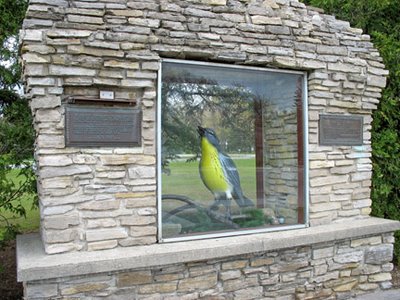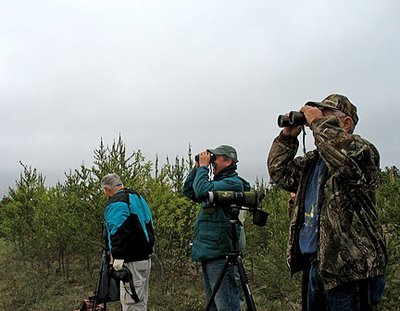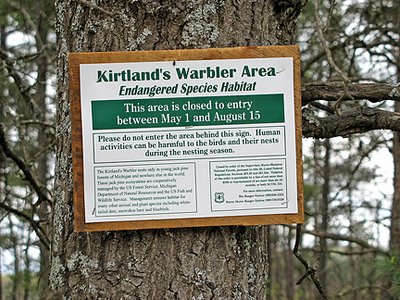Search This Blog
Friday, May 19, 2006
Kirtland's Warbler, endangered species
After our stop at Magee Marsh, Ohio, we went to Mio, Michigan, located in the upper part of Michigan's lower peninsula, to see the Kirtland's Warbler. Now this is not just any old warbler, this is one of the rarest songbirds in North America. Last year they counted only 1,417 singing males. This is a federally endangered species that nests in just a few places in Michigan's lower and upper peninsula, a little in Wisconsin and Ontario, and nowhere else.
The reason this bird is endangered, is that it requires a very particular habitat of young Jack Pine trees between about 5 and 20 feet tall, and prefers stands of trees that are at least 80 acres or up to 1000 acres. They nest on the ground under the lower branches of the pines. Picky, picky, that's why you wind up as an endangered species. Seriously though, one of the reasons birds become endangered is that they require highly specialized habitats. When those habitats go, due to development or other reasons, the birds do also. Habitat generalists such as say, House Sparrows, have little reason to fear becoming endangered, at least for now.
Jack Pine trees require fire to open their cones and release their seeds. In modern times with greater prevention of forest fires, Jack Pines declined and so did Kirtland's Warblers. There is now a huge federal management program to ensure the continuance of this very special habitat. The Jack Pine stands are managed by seeding, replanting and burning. In addition, Brown-headed Cowbirds, who lay their eggs in Kirtland's Warblers nests and reduce the number of Kirtland's offspring produced, are trapped and removed from the region.
To see the Kirtland's Warblers you need to take a tour offered by the U.S. Forest Service, Mio Ranger Station, Mio Michigan. (There are also tours offered by the U. S. Fish and Wildlife Service out of Grayling, MI.) Show up at the Mio Ranger Station at 7:00 am on your appointed day. We were there the first day they began to lead tours, May 15th. Tours run through July 2nd.
Our group was lead to suitable habitat by leader Phil Huber. We stopped by the roadside and heard a Kirtland's singing down the road behind us. We walked there but could not see it. Phil said to wait awhile, sometimes they pop up and sing from the dead trees sticking above the Jack Pines. Don stood on a little rise and finally spotted our first bird, Hooray! What a beautiful little bird. It was far, more than 200 feet, and obscured by leaves but we viewed it through Phil's scope (and I digiscoped it through the scope). Phil then admitted we were lucky to see it, since this was the first day of the tours and many of the warblers had not yet returned. For the best chance of seeing the warblers you should go between May 20th and June 20th.
We then went to a second area that looked promising and heard 3 more Kirtland's. One of those gave us a better look than the first one (see top photo) but it was still more than 100 feet away. In the area we also heard lots of Nashville Warblers, who also like that habitat. At our final stop we all listened from the road but did not hear anything. We walked in a path and came to an area where the trees were quite low and were treated to a look at an Upland Sandpiper, a very cool shorebird with an unusual call. It was more than 300 feet away viewed through a scope. A Brewer's Blackbird also popped up on a dead snag.
Kirtlands Warbler Festival is held tomorrow on May 20th. Try and go, if not then, then soon, to see this amazing and beautiful warbler, a real survivor.
The photos of birds were digiscoped (I held the Canon powershot camera up to the scope) breaking all the rules for digiscoping which are:
- Digiscope in sunny conditions
- You should be no more that 50 - 75 feet away from small birds, 100 - 150 feet from large birds.
But hey, at least I got some photos.
Lillian's rule:
Be sure and break the rules sometimes.












No comments:
Post a Comment